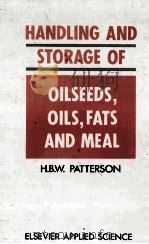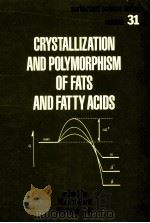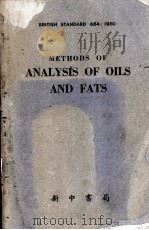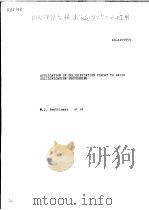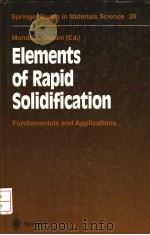《MELTING AND SOLIDIFICATION OF FATS》
| 作者 | ALTON E. BAILEY 编者 |
|---|---|
| 出版 | 未查询到或未知 |
| 参考页数 | 357 |
| 出版时间 | 没有确切时间的资料 目录预览 |
| ISBN号 | 无 — 求助条款 |
| PDF编号 | 811644438(仅供预览,未存储实际文件) |
| 求助格式 | 扫描PDF(若分多册发行,每次仅能受理1册) |
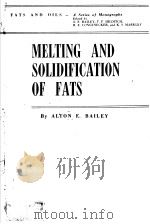
Ⅰ.General and Theoretical Considerations1
A.Structure of Fatty Molecules1
1.Size and Shape of Atoms and Molecules1
2.Structure of a Saturated Fatty Acid Molecule2
3.Structure of Unsaturated Acid Molecules2
4.Structure of Glycerides3
B.Thermal Agitation4
C.Intermolecular Forces5
1.Dipole Attraction5
2.Hydrogen Bonding7
3.Van der Waals Forces8
4.Internal Pressure9
D.Structure of Liquids9
E.Structure and Properties of Crystals11
1.Geometry of Crystals11
2.Classification of Crystals12
3.Lattice Planes;X-Ray Diffraction12
4.The Unit Cell of Stearic Acid15
5.Anisotropy;Double Refraction17
6.Crystal Habit19
7.Polymorphism22
8.Transformations without Alteration of the Lattice24
9.Crystals from Multicomponent System25
(a)Compound Formation25
(b)Solid Solutions26
(c)Layer Crystals28
F.Formation and Dissolution of Crystals29
1.General Characteristics of the Solid-Liquid Transformation29
2.Some Thermodynamic Considerations29
3.Theory of Melting33
(a)Classical Theory33
(b)Modern Views of the Melting Process34
4.Crystal Nuclei36
(a)Nucleus Formation37
(b)Persistence of Crystal Nuclei41
(c)Surface Effects43
(d)Inhibition of Nucleus Formation44
5.Crystal Growth45
G.Melting in Mixtures and Solutions46
1.Notes on the Terminology of Melting and Solution46
2.Vapor Pressures of Solid and Liquid47
3.The Ideal Solution48
4.Calculation of Ideal Solubility48
5.Deviations from Ideality51
(a)Types of Deviation51
(b)Miscellaneous Characteristics of Nonideal Solutions51
(c)Measurement and Prediction of Deviations53
(d)Solid Solutions56
H.Phase Diagrams59
1.Nature and Applicability of Phase Diagrams59
2.General Principles60
3.Binary Diagrams61
4.Ternary Diagrams67
5.Difficulty of Attaining Equilibrium in Fatty Systems72
Ⅱ.Laboratory Techniques75
A.Introduction75
B.Thermal Methods77
1.Melting in Capillary Tubes77
(a)Melting Points of Pure Substances77
(b)Melting Points of Mixtures.The Thaw Point79
(c)Melting Points of Unstable Forms79
2.Solidification Points80
(a)Solidification Temperatures of Pure Substances80
(b)Solidification Points of Mixtures81
3.Comparison of Melting and Solidification Points83
4.Thermal Analysis83
(a)Apparatus for Heating and Cooling Curves84
(b)Examination of Polymorphic Substances85
5.Calorimetric Examination86
(a)Apparatus and Methods86
(b)Use of the Nernst-Type Apparatus88
(c)Interpretation of Heat Content Data90
C.Dilatometric Methods91
1.Comparison of Calorimetric and Dilatometric Curves91
2.Apparatus94
3.Dilatometric Techniques97
4.Melting Points by Dilatometry99
D.Estimation of Proportions of Solids and Liquids100
E.Solubility Determinations105
F.Estimation of Fatty Acid Composition by the Method of Mixtures106
G.Miscellaneous Physical Chemical Methods107
1.X-Ray Diffraction107
2.Dielectric Constants;Polarization108
3.Microscopic.Examination108
H.Control Methods for Commercial Fats109
1.Melting,Slipping,and Softening Points109
2.Solidifying Points111
(a)Titer111
(b)Setting or Congeal Point112
3.Cloud Points112
4.Cold Tests113
5.Measurements of Consistency113
(a)Methods for Finished Products114
(b)Methods for Unfinished Fats115
Ⅲ.Melting and Solidification of Pure Compounds117
A.Crystal Structure;Polymorphism117
1.Fatty Acids117
(a)Saturated Acids117
(b)Unsaturated Acids122
2.Triglycerides123
(a)Simple Saturated Triglycerides123
(b)Simple Unsaturated Triglycerides126
(c)Mixed Saturated Triglycerides127
(d)Mixed Unsaturated Triglycerides136
(e)Polymorphism of Odd-Chain Glycerides;Alternation136
3.Diglycerides138
4.Monoglycerides140
5.Interpretation of X-Ray Data143
B.Melting,Solidification,and Transition Points145
1.Fatty Acids146
(a)Saturated Acids146
(b)Unsaturated Acids149
(c)Conjugated Acids and Other Acids of Unusual Structure152
2.Triglycerides153
(a)Simple Triglycerides153
(b)Mixed Saturated Triglycerides155
(c)Mixed Unsaturated Triglycerides165
3.Diglycerides166
4.Monoglycerides168
5.Effect of Esterification,Unsaturation,Isomerisation:A Summary170
C.Latent Heats and Volume Changes171
1.Heat and Entropy of Fusion171
2.Heat of Transition175
3.Volume Changes Accompanying Fusion and Tran?tion176
4.Correlation of Thermal Effects and Volume Changes178
Ⅳ.Melting and Solidification of Mixtures181
A.Binary Systems of Fatty Acids181
1.Melting and Solidification Points181
(a)Systems Comprising Two Saturated Fatty Acids181
(b)Systems of Two Unsaturated Acids192
(c)Systems of One Saturated and One Unsaturated Acid194
2.Analysis of Experimental Data196
(a)Calculation of Melting Points on Assumption of Ideal Solubility196
(b)Two Saturated Acids Differing in Chain Length by Two Carbon Atoms198
(c)Two Saturated Acids Differing in Chain Length by More Than Two Carbon Atoms204
(d)Two Saturated Acids Differing in Chain Length by One Carbon Atom205
(e)Two Unsaturated Acids205
(f)One Saturated and One Unsaturated Acid205
3.Crystal Spacings of Mixtures.Polymorphism208
4.Crystal Habits of Mixtures211
5.Thermal Effects and Volume Changes212
B.Binary Glyceride Systems212
C.Ternary Systems215
1.Saturated Fatty Acid Systems215
2.Systems Containing Unsaturated Acids219
3.Glyceride Systems221
D.Fatty Acid-Glyceride Systems221
E.Commercial Fats222
1.Melting Point Lowering of One Component by Another224
2.Course of Melting in Plastic Fats227
3.Heats of Fusion and Melting Dilations237
Ⅴ.Solubility239
A.Introductory239
1.Methods of Expressing Solubility239
2.Evaluation of Solubility Data240
3.Solubility Curves240
4.Ideal Solubilities247
B.Solubility of Fatty Acids247
1.Saturated Acids249
(a)In Acetone and 2-Butanone,and in Methyl,Ethyl,and Butyl Acetates249
(b)In Chlorinated Aliphatic Solvents257
(c)In Alcohols259
(d)In Glacial Acetic Acid261
(e)In Aromatic Solvents262
(f)In Heterocyclic Compounds267
(g)In Nitrogen-Containing Compounds268
(h)In Hydrocarbons269
(i)In Water271
(j)In Other Solvents274
2.Unsaturated Fatty Acids275
3.Solubility of Fatty Acids in Relation to Properties of the Solvents276
C.Solubility of Fatty Acid Mixtures277
D.Solubility of Glycerides284
Ⅵ.Practical Melting and Solidification Processes291
A.Consistency in Plastic Fats291
1.Structure of a Plastic Fat291
2.Measurement and Evaluation of Flow Properties292
(a)Characteristics of Ideal Viscous and Plastic Flow292
(b)Types of Apparatus for Consistency Measurement293
(c)Application of the Capillary Tube Method294
(d)Penetrometric Methods297
3.Factors Influencing Consistency300
(a)Proportion of Solids in the Fat300
(b)Physical Properties of the Crystals300
(c)Viscosity of the Liquid302
(d)Temperature Treatment302
(e)Mechanical Working305
(f)Persistent Supercooling307
(g)Polymorphism308
4.Melting and Consistency of Commercial Fats309
(a)Butterfat312
(b)Animal Fats314
(c)Vegetable Butters315
(d)Lauric Acid Oils318
(e)Other Vegetable Oils318
(f)Highly Hydrogenated Oils or Stearines320
(g)Shortenings and Margarine Oils322
B.Solidification of Plastic Edible Fats325
1.Lard and Shortenings325
2.Margarine327
C.Solidification of Hard Fats327
D.Fractional Crystallization328
1.Principles328
2.Isolation of Fatty Acids and Glycerides of High Purity334
3.Analysis of Fats336
4.Separation of Glycerides or Fatty Acids from Nonfatty Ma-terials338
5.Commercial Fractionation of Fatty Acids339
6.Commercial Fractionation of Glycerides343
(a)Winterization of Vegetable Oils343
(b)Production of Oleo Oil344
(c)Fractional Crystallization of Other Fats and Oils345
(d)Fractional Crystallization of Fats from Solvents345
Author Index347
Subject Index353
《MELTING AND SOLIDIFICATION OF FATS》由于是年代较久的资料都绝版了,几乎不可能购买到实物。如果大家为了学习确实需要,可向博主求助其电子版PDF文件。对合法合规的求助,我会当即受理并将下载地址发送给你。
高度相关资料
-
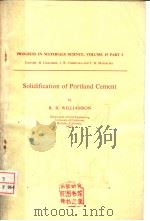
- SOLIDIFICATION OF PORTLAND CEMENT
- PERGAMON PRESS
-

- ENVIRONMENTAL ASPECTS OF STABILIZATION AND SOLIDIFICATION OF HAZARDOUS AND RADIOACTIVE WASTES
- 1989 AMERICAN SOCIETY FOR TESTING AND MATERIALS
-
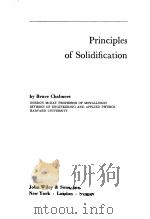
- PRINCIPLES OF SOLIDIFICATION
- 1964 JOHN WILEY & SONS INC
-

- HYDROGENATION OF FATS AND OILS
- 1983 APPLIED SCIENCE PUBLISHERS
-

- VEGETABLE FATS AND OILS
- 1954 AMERICAN CHEMICAL SOCIENTY
-
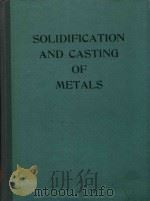
- SOLIDIFICATION AND CASTING OF METALS
- 1979 THE METALS SOCIETY
-

- ANALYSIS OF OILS AND FATS
- ELSEVIER APPLIED SCIENCE PUBLISHERS
提示:百度云已更名为百度网盘(百度盘),天翼云盘、微盘下载地址……暂未提供。➥ PDF文字可复制化或转WORD
